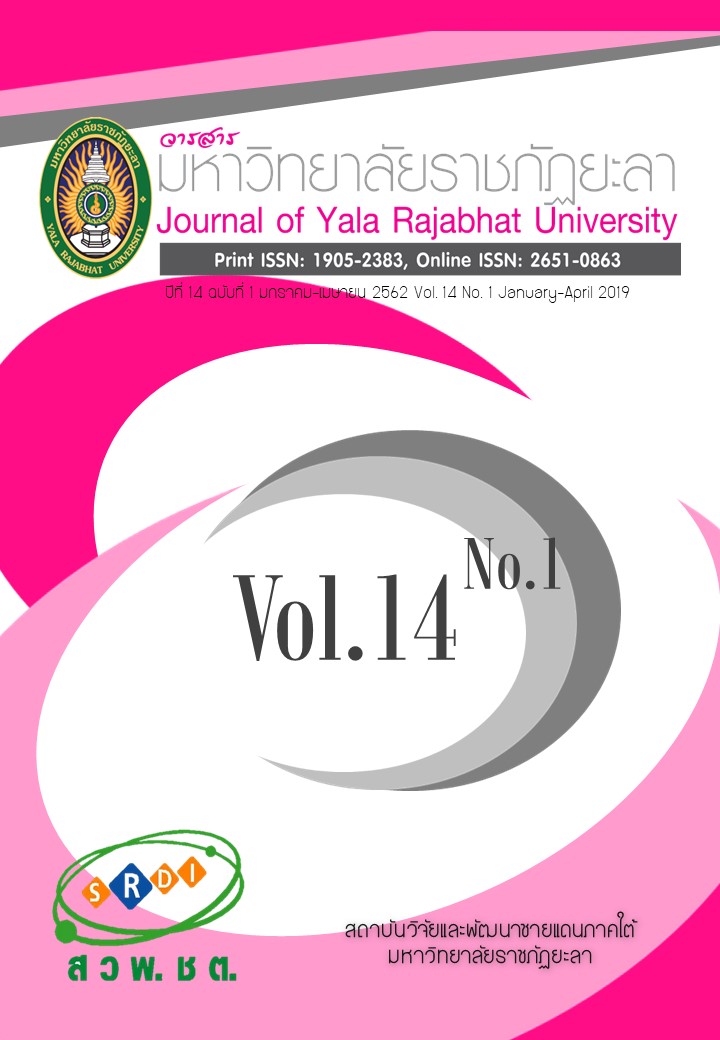การพัฒนาตัวบ่งชี้สมรรถนะด้านไอซีทีสำหรับผู้สอนในมหาวิทยาลัยราชภัฎ
Main Article Content
บทคัดย่อ
การวิจัยนี้มีวัตถุประสงค์เพื่อพัฒนาตัวบ่งชี้สมรรถนะเทคโนโลยีสารสนเทศและการสื่อสารของบุคลากรสายการสอนมหาวิทยาลัยราชภัฏและทดสอบความสอดคล้องของโมเดลตัวบ่งชี้สมรรถนะเทคโนโลยีสารสนเทศและการสื่อสารของบุคลากรสายการสอนมหาวิทยาลัยราชภัฏจากการพัฒนาขึ้นกับข้อมูลเชิงประจักษ์ เก็บรวบรวมข้อมูลจากบุคลากรสายการสอน มหาวิทยาลัยราชภัฏกลุ่มภาคตะวันตก จำนวน 204 คน ได้มาโดยใช้วิธีการสุ่มของ Comrey & Lee (1992) ผลการตรวจสอบความสอดคล้องของโมเดลตัวบ่งชี้สมรรถนะเทคโนโลยีสารสนเทศและการสื่อสารของบุคลากรสายการสอนมหาวิทยาลัยราชภัฏจากการพัฒนาขึ้นกับข้อมูลเชิงประจักษ์ ได้ค่าไค-สแควร์ (c2) =232.16,df =239, P= 0.61224, GFI=0.92,AGFI=0.87 และ RMSEA=0.000สรุปได้ว่า ตัวบ่งชี้สมรรถนะเทคโนโลยีสารสนเทศและการสื่อสารของบุคลากรสายการสอนมหาวิทยาลัยราชภัฏมี 6 องค์ประกอบ 28 ตัวบ่งชี้ ได้แก่ 1) ความรู้พื้นฐานทางไอซีทีมี 13 ตัวบ่งชี้ 2) การจัดการเรียนรู้ด้วยไอซีที มี 6 ตัวบ่งชี้ 3) จรรยาบรรณด้านไอซีทีมี3 ตัวบ่งชี้ 4) การวัดและประเมินผลห้องเรียนด้านไอซีทีมี1 ตัวบ่งชี้ 5) การบริหารจัดการในห้องเรียนด้วยไอซีทีมี3 ตัวบ่งชี้ และ 6) การพัฒนาคนมี2 ตัวบ่งชี้
Article Details
บทความ ข้อมูล เนื้อหา รูปภาพ ฯลฯ ที่ได้รับการเผยแพร่ในวารสารมหาวิทยาลัยราชภัฏยะลานี้ ถือเป็นลิขสิทธิ์ของวารสารมหาวิทยาลัยราชภัฏยะลา หากบุคคลหรือหน่วยงานใดต้องการนำทั้งหมดหรือส่วนหนึ่งส่วนใดไปเผยแพร่ต่อหรือกระทำการใดๆ จะต้องได้รับอนุญาตเป็นลายลักษณ์อักษรจากวารสารมหาวิทยาลัยราชภัฏยะลาก่อนเท่านั้น
เอกสารอ้างอิง
2. Kaiyawan, Y. (2001). Multivariate Statistical Analysis for Research. Doctoral Dissertation. Department of Technological Management. Phetchaburi Rajabhat University. (in Thai)
3. Ministry of Education. (2008). Basic Education. Bangkok: The Agricultural Cooperative Federation of Thailand. Limited. (in Thai)
4. Ministry of Information and Communication Technology. (2007). ICT 2020 Conceptual Framework. Bangkok: Thana & Graphic Press. (in Thai)
5. Office of the National Economics and Social Development Board. (2006). National Economic and Social Development Plan No. 10, (2007-2011). (in Thai)
6. Onthawon, K. & Mungsing, S. (2015). A Development ICT Competency Indicator Model for Faculty Member in Institute of Physical Education–Thailand. Academic Journal Institute of Physical Education, 7(1), 209-221. (in Thai)
7. Silpcharu, T. (2012). Research and Statistical Analysis Using SPSS and AMOS. Nonthaburi: S.R. Printing Mass Products, Co., Ltd. (in Thai)
8. Sukkasem, K. & Prasith-rathsint, S. (2007). Handbook of LISREL applications. Bangkok: Samlada Co., Ltd. (in Thai)
9. UNESCO. (2008). ICT Competency Standards for Teachers. United Kingdom: United Nations Educational, Scientific and Cultural Organization.
10. Yossiri, W., Rawichart, N., Hayeesani, M., Karaminae, N., Laongpol, J., Vongsvivut, S., et al. (2017). The Study of University Teachers’ Desired Characteristics in English Language Teaching and Learning as Perceived by Yala Rajabhat University Students. Journal of Yala Rajabhat University, 12(Special Issue), 86-99. (in Thai)


